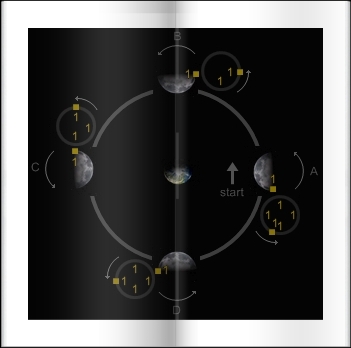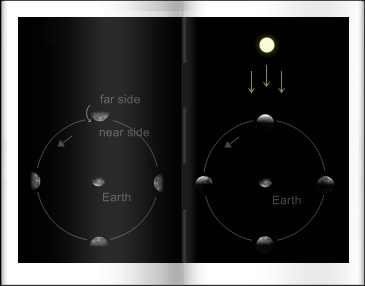
| CONTENT - All about our Moon's phases |
Mean distance between Moon's and Earth's centers is 239,000 miles. Moon's orbit has a feeble eccentricity and Moon's orbit plane is tilted by 5.1° relative to Earth's equatorial plane (for a more complete table of data about Moon, see the tutorial "Figures About the Moon" in section Theory. Advanced)
Moon's phases are mainly due to Moon's revolution period equaling its rotation period. Moon orbits Earth in 27.3 days and it rotates in 27.3 days too. This resonance was built along time since Earth and Moon were created. It was created by gravitational interactions between both. A point at Moon's surface has rotated once when Moon has completed one orbit around Earth (see point 1 on following sketch). On another hand, a point located at Moon far side will always remain invisible from Earth. Hence Moon has a near and a far side. Far side remained unknown until space age

27.3 days is the duration of Moon's orbital revolution relative to stars background. Moon's phases have a real duration of 29.5 days, that is the time Moon takes to complete a full cycle starting at the Earth-Sun line and back. Or -what is equal- to accomplish a complete lunar cycle: to go from one phase to the same phase. Moon 27.3 days revolution is called a sidereal month; 29.5 days cycle, from phase to phase, is called a synodic month. The time between two perigees is called a anomalistic revolution as the draconitic revolution of the Moon is the cycle of the line of knots, or 18.6 years (in the retrograde direction on the lunar orbit; in terms of both lunar and solar eclipses, that cycle is a 'saros')

Moon's phases are due to Moon differently illuminated by Sun's rays along its orbit around Earth:
 | click to Moon's phases |
In the northern hemisphere, just after the new moon, the first crescent Moon appears West. Because the ecliptic is at a angle which varies to the horizon, waxing crescent, by the mid-latitudes, is seen higher in the sky by spring than by fall, and the reverse for the waning one. Day after day, crescented Moon gets distant from the Sun at the same time is increases in size. The very first -or last- crescent is theoretically observable when lying at at least 7° from the Sun, as conditions vary function of the observer's location, the time of the observation, and other factors. At first quarter Moon appears full South when Sun sets. The quarter Moon become waxing gibbous and it appears more East each day. When Moon reaches full, it's rising East just when Sun is setting West. Moon then sets in turn about 12 hours later that is by next morning. Waning gibbous Moon rises later each day until it reaches last quarter. Moon then rises at midnight and sets about midday. The last crescent completes the cycle as it rises less and less early before Sun. At the equator the sequence unfolds approximately the same except that Moon is usually seen lying on its side as it is usually high in the sky. The ecliptic there is often at a sharp angle to the horizon. In the southern hemisphere, the sequence is the same than in the North at these exceptions that Moon is seen upside-down and that the ecliptic is seen on the northern horizon hence the sequence of Moon's phases begins West and then turn northwest, North, etc. Each day, in mid-northern latitudes, Moon is rising later by an average of 50 mn each day. This interval of time is varying between 70 mn and 30 mn along the year due to the different inclination of the ecliptic on the horizon. The maximum delay is reached in January as the minimum occurs in September. This Moon is called the "Harvest Moon" as farmers used to make their last harvests before autumn benefiting from this extra light at full Moon time. When two Full Moon occur in a same month, which is a rare occurrence, the second one is called a 'Blue Moon.' The Moon behaves exactly in the opposite in the southern hemisphere. Generally, the Moon is moving each night by about 12.5° relative to the background stars (which is about one Moon's diameter each hour). Moon, on a other hand, due to its orbit's characteristics, never ventures more than 5° either side of the ecliptic
When Moon is in first crescent on western horizon, one may sometimes see the dark part of the lunar disk slightly shining. This is called the "ashen light", the "ashen glow", or the "Earthshine", and it is a fine show. Moon's part which is still in night is lit by "earthshine". For an observer located on the Moon it would be night and Earth would be shortly after "Full Earth". The ashen glow is seen too at last quarter Moon when last crescent is rising on eastern horizon. The concept of earthshine was first proposed by Leonardo da Vinci. A popular expression is terming the ashen glow "the old Moon in the New Moon's arms". Seen from Moon, Earth is 2° wide in the sky, that is four times larger than Moon seen from Earth. Earth's albedo -part of sunlight Earth is reflecting back space- is varying. Hence Earthshine was found to vary. A long time variation has been found working on an yearly basis: Earthshine is brighter (about 10 percent) in April and May. Main explanation for such a variation is Earth's cloud cover of course. Cloud cover is Earth's main reflectivity factor. Cloud cover is varying along the seasons due to climate's large scale patterns. The ashen glow may even be seen waxing and waning (by about 5 percent) on an hourly basis to an attentive observer. This is better due to what part of Earth is seen at Moon: Pacific Ocean, with its dark blue, is surely reflecting less light than a continent. Our planet's average albedo in recent years is 0.297 plus or minus 0.005. The same causes which make the earthshine vary at Moon due to the a difference of albedo between the oceans and landmasses might help to better assess the variations of light emitted by an exoplanet at it rotates, the only mean, for long, to have any idea of the surface of those
Website Manager: G. Guichard, site 'Amateur Astronomy,' http://stars5.6te.net. Page Editor: G. Guichard. last edited: 3/17/2014. contact us at ggwebsites@outlook.com